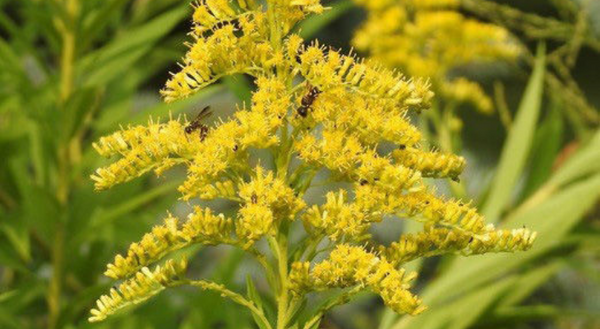
Roadside weed, or golden torch beckoning all the bees in the neighborhood?
Tall and gangly, goldenrod offers the latter to interested gardeners. My front landscape bed is dedicated to pollinators, so I have planted native Showy goldenrod (Solidago speciosa) right in the middle, and it has not disappointed in its floral show and its magnetic qualities for pollinators.
To identify what species of goldenrod you are growing, or one you encounter in the wild, Chicago’s Field Museum has published Common Goldenrods of the Chicago Region, highlighting 18 different species.
Goldenrod is essential for pollinator-friendly gardens, especially if a goal is to providing late season nectar sources for Monarch butterflies. Goldenrod’s fall flowers offer a critical supply of food and nutrients when insects are preparing for long winter months. The flowers also attract honeybees, bumblebees, ants, beetles, and the occasional moth or butterfly. Among the beetles, Goldenrod Soldier Beetle, which I have dubbed The Great Pollinator. Bright yellow, the beetle resembles a lightning bug, and is the most abundant soldier beetle found at this time of the year.
Showy goldenrod grows 4 feet tall, featuring a large panicle of compound flowers that last a month. It thrives in full sun but can take some morning shade. There are some cultivars that will give you this vibrant floral display on top of more compact growth like ‘Crown of Rays.’ It only grows one to two feet tall and blooms in July and lasts until September.
Some gardeners pinch the tips of the shoots of native goldenrods in May, or cut back the stems by half in June to create a more compact plant in the fall that will have no issues holding up the large flowers. Dividing the plant every four years keep its rhizomes under control.
Goldenrod does not cause seasonal allergies. Many people misidentify goldenrod as ragweed, the more likely trigger for their seasonal misery. Goldenrod’s heavy, sticky pollen is only carried by insects. Ragweed’s fine yellow pollen, however, blows in the wind.
If you are the type to love fall blossoms with bees buzzing, then goldenrod is the plant for you. Other great fall bloomers that attract pollinators are blue beard (Caryopteris x clandonensis), Common Bonset (Eupatorium perfoliatum), Aster (Aster spp.), and blazing star (Liatris).